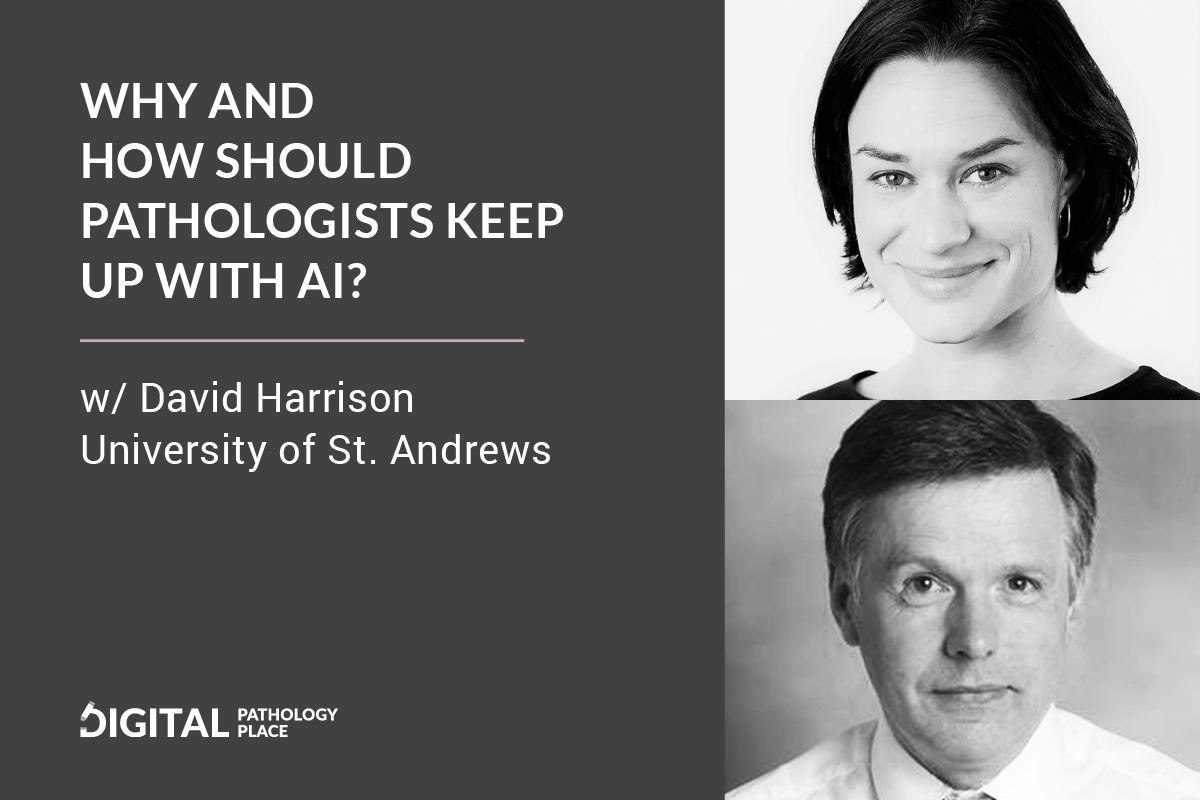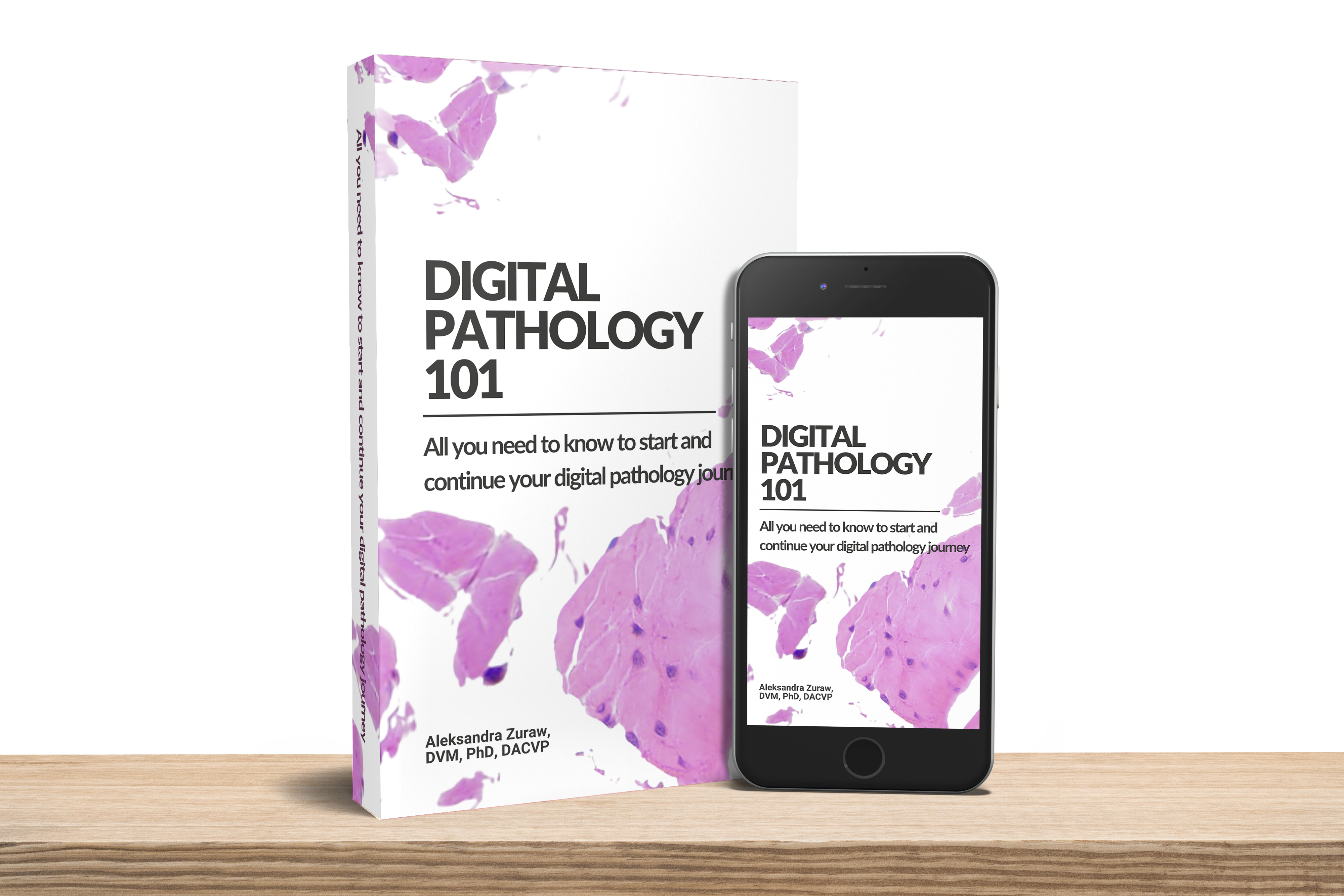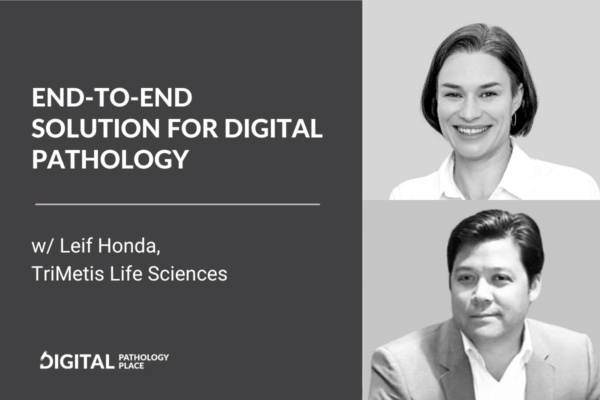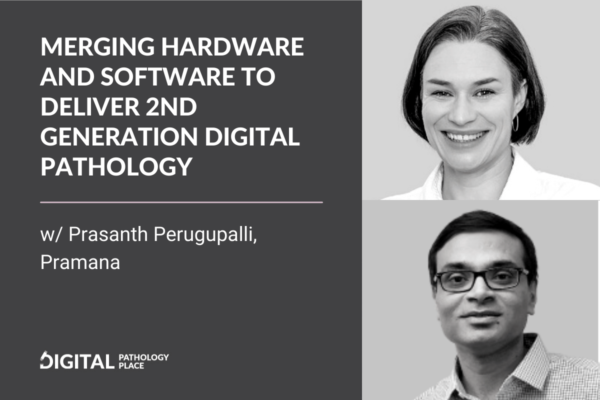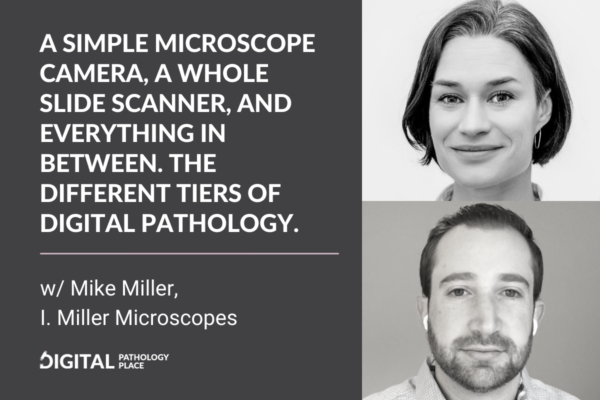Aleksandra Zuraw: [00:01:14] My guest is Dr. David Harrison. He is a pathology professor at St. Andrews University in Scotland and a member of Visiopharm’s scientific advisory board. He’s specialized in liver and kidney, but his research interests also include artificial intelligence applications in pathology. David is director of several small biotech companies, chairperson of several charities, and director of iCAIRD Industrial Center for AI Research in Digital Diagnostics, a consortium funded by Innovate UK.
How are you, David?
David Harrison: [00:01:49] I’m very well. Thank you. Good to speak to you again.
Aleksandra: [00:01:52] Thank you so much for being my guest. Let us start with the introduction. Tell us about your background and what led you into the digital pathology path.
David: [00:02:03] So I’m a medically trained histopathologist based in St. Andrews, which is near Edinburgh in Scotland.
[00:02:11]I’m professor of pathology in St. Andrews and I also [00:02:14] have honorary professorships in the universities of Edinburgh and Glasgow. So, how did I get to digital pathology? Interesting question. My clinical interests have been kidney, liver, transplant pathology. And I guess in that discipline frequently, the biopsy doesn’t actually give you an answer.
[00:02:35] It gives you something that you have to then discuss with clinicians. And I think quite some years ago, I discovered that it was much easier to have that discussion if you’re actually talking about an image of the biopsy or actually looking at the biopsy under the microscope. So I developed that practice, that biopsies would be discussed around the image as technology evolved.
[00:03:03] It was then possible to do that remotely by capturing an image on a screen. And that meant I could do that even if I was traveling or if I was away from [00:03:14] the office. And then from that, I began to consult with colleagues, asking their opinion or providing an opinion to them. And then eventually made that transition to sometimes using it for the first look to make a primary diagnosis.
[00:03:31] So very much an evolution not driven because I thought this is the way to go, but driven because at every stage it seemed the appropriate way forward. And because I became more confident and as the technology became better, it became really a very useful part of my professional practice.
Aleksandra: [00:03:53] So, where are you active in digital pathology now at your university at any other organization?
David: [00:04:03] My interests currently I really at the leading edge, I hope of digital pathology is what information can we extract from tissue? [00:04:14] So of course we live on the omix revolution. We know genomics and transcriptomics, and all of these things add hugely to the precision medicine agenda.
[00:04:25] But I think, tissue sections still retain a huge amount of information, and then using techniques like multiplex, immunofluorescence can add to that. So my interests, research interests are really trying to see how much more information can we extract from tissue and then putting the tools in place, image analysis, statistics, even moving to machine learning.
[00:04:50] How can we use those tools? To integrate that information to provide the best possible advice to clinicians.
Aleksandra: [00:05:01] When I read the digital pathology literature, my wish is always to have the new methods, new integrations, omics, and all these new things publicly available, [00:05:14] ideally commercially available for wider audience as soon as possible. Obviously, this is not always the case. You are part of the industrial center for artificial intelligence research in digital diagnostics iCAIRD. Can you tell us what that is? And I imagine this institution is tasked with just that, with bringing their research solution that you just talked about into the industry.
David: [00:05:40] Absolutely. So iCAIRD, easier to use the short version I think. ICAIRD is one of the five UK centers of excellence on digital diagnostics.
[00:05:51] So it’s funded both by government and by industry and its main mission is actually to bring hospitals and industry and academia together to develop AI use, in our case both pathology and radiology. So it’s very much exploring every stage of the process from here’s the tissue [00:06:14] right through to here is as you’ve already said, a product that we can actually implement safely in practice.
[00:06:22] So it’s cross-disciplinary, it’s bridging industry, hospitals, and academia, and it’s based in the main part in one department in Glasgow, which is almost 50 senior consultants and we’re converting them to food digital, but then working with St. Andrews University, Edinburgh University to develop algorithms in partnership with industry that ultimately we want to be used and deployed.
Aleksandra: [00:06:50] So you have five of these centers?
David: [00:06:53] There’s four based in England and then there’s iCAIRD based in Scotland.
Aleksandra: [00:06:57] And what is your role there?
David: [00:06:59] So I’m director I’m not quite sure what the director does, but I think my trying to coordinate all the activities to bring people on board.
[00:07:07] And I think always to the cohorts, this isn’t about oh a center of excellence that we put our arms [00:07:14] around and keep to ourselves. This is very much meant to be an opportunity for people to come and see to learn. It’s meant to be open and inclusive. And of course that all takes time. So my role is as director, there’s a great team of pathologists who actually deliver on the ground digitization of practice.
[00:07:34] So it’s a leadership role. But a leadership role that I’m delighted to take because it really does give me the opportunity to, to put what I’d been doing for a number of years, hopefully into practice that allows us to roll out digital pathology.
Aleksandra: [00:07:49] So putting this multidisciplinary systems approach into practice, one of the tools that are being used for that is artificial intelligence and we have to embrace it. How can pathologies keep up with these new developments? First, how did you even start using AI? I mean, you started your career [00:08:14] before AI was a thing in pathology.
[00:08:16] What was your path in the AI space and how can pathologists keep up with this? Because probably not everyone is exposed to this, but we will have to.
David: [00:08:26] Yeah, that’s a fair point, but I would respond and say: actually, I couldn’t build a microscope, but I do know how to use one. So I think AI actually should be regarded as a tool.
[00:08:40] It’s something we are developing, it’s something being developed, but I don’t think pathologists should feel that they have to be the people who are developing it. So I think it’s a tool and I think the importance of pathologists, engaging with the development of AI as a tool is that we actually inform its development and make it more clinically relevant and applicable.
[00:09:02] So I think that’s the first thing it’s almost to take away the mythology that AI is some high, vastly different, actually, it’s augmenting the intelligence that we already apply rather than doing [00:09:14] something entirely new. In terms of how we build that into the profession. I actually think we have to start right from the undergraduate stage.
[00:09:23] I think pathology is undergoing a revolution. I think it has undergone a revolution with monoclonal antibodies from the 1980s. I think we continue to undergo a revolution. So I think getting that exposure at the undergraduate stage to medical students, one, it will actually attract perhaps different types of people into pathology.
[00:09:47] But it would also become part of the thinking about this is how pathology does its job. I think then it’s having exemplars that work be that through centers of excellence, published papers, commercial products, it’s actually having pathologist be able to see it not, Oh, we’re going to buy it and use it, but actually seeing it, talking to colleagues, exploring, debating, discussing whether this is for [00:10:14] them.
[00:10:14] And then, of course, I think, continuous professional development either provided from industry or from academia or from hospitals, I think it’s very important in terms of ongoing professional buy-in, which is essential. I think there are lessons probably from the application of molecular pathology because in some centers that was very much embedded within the pathology department.
[00:10:40] But in other centers, it’s actually very much embedded within a genetics department and the communication, needs, and requirements are different in those different settings. So I think it’s something where there needs to be a degree of thoughts and fore planning. But a lot of it, I think is just getting the message out there.
[00:11:00] Actually, this isn’t frightening. It’s not scary actually, in some ways it’s not even new, but it helps, it augments what we’re able to do. And I think it’s that, that entire process from medical [00:11:14] student direct through to professional the continuous exposure to showing actually this works, I think that’s what we need to do.
Aleksandra: [00:11:21] And let’s say people, some pathologists are not interested in that. We know that it’s going to come and it’s going to be used. Do they have to get interested or is it just going to come, and they will be exposed to like you say, it’s just a new tool and they will have to learn that tool, and that’s okay.
David: [00:11:39] That’s always an interesting, what happens when technology changes for some people are at the front edge for adopting. I don’t think I’m particularly a computer literate, AI-literate pathologist. I’m a pathologist who wants to do a job, but I think other people are much more reticent than much more unwilling.
[00:11:58] And I think this is not going to happen suddenly. I think it’s going to happen in specific instances perhaps in specific diseases. I think there is time for people to come on board and ultimately some of our colleagues may well, [00:12:14] never have to come on board because perhaps they reach retirement before they really have to face it.
[00:12:19] I think it will come. I think all pathologists will have to engage with AI, but I do think it will be a gradual process rather than an immediate revolution.
Aleksandra: [00:12:29] So how can AI exactly be used in pathology? Obviously, it is used for analyzing images, but where can it help in the pathologist’s workflow?
David: [00:12:41] So I think in a number of areas, and perhaps it’s worth starting by saying, I don’t think its primary benefit is necessarily to make the diagnosis and replace pathologists.
[00:12:52] Actually, I think that’s worth talking about, but that’s not the point. I think the first thing that AI does is it actually makes things easier. It runs things better. So it might sound very unambitious, but I think one of the best things AI will do in pathology is actually to help us manage workflow.
[00:13:12] That might be at the level [00:13:14] of requesting immunohistochemistry. It might be triaging samples and saying, you know, I don’t think this, the skin biopsy has got anything worrying. So you don’t need to look at that Mr. Pathologist or Mrs. Pathologist or Ms. Pathologist. You don’t need to look at that slide as an urgent because I’d much rather you focused on this.
[00:13:34] So I think one of the biggest advantages of AI is that you’re going to be aiding workflow, triaging cases that are safe, that are, if you like normal, and then allowing the pathologist to focus on cases that are perhaps more urgent or more high risk. But I think it’s more than that. We know the tumor grading or biomarker assessment is important.
[00:13:59] But actually it’s quite difficult. It’s difficult because we as humans find it difficult to actually quantify. But the other thing that makes it difficult is that tumors are heterogeneous. So do we report the average? Do we report [00:14:14] the worst area? Do we report the best area? And there are different schemes in different diseases.
[00:14:19] With AI, what we’re able to do is actually move from a single number to actually reporting a distribution. So I think we can measure objectively. I think we can also begin to explore things that we know are important, like the relationship between tumor stroma, but actually, there’s nothing really by high we can measure.
[00:14:40] So I think we actually begin to measure things that we can’t really measure it all by. I can’t estimate, but we knew that important, those spatial relationships between things. And I think AI allows us to do that in a way that’s actually very difficult for us to do. And then, of course, I think we move to precision medicine, not just the diagnosis and the prognosis, but also beginning to make predictions and the summary of the elegant work out there. For example, where the tissue section can indicate the [00:15:14] likely mutational spectrum. I think that’s huge potential bringing that interrogation of the sample together with genomics together with immunoperoxidase or immunofluorescence approaches. So I think that predictive value as well.
[00:15:32] And then I think one of the big challenges in pathology, of course, is. Laboratories do things differently. And even when they try and do it the same, we end up with different results. We end up with different staining characteristics. We end up with subtly different, positive versus negative. For example, if we’re doing a biomarker and I think AI actually has the capability of trying to even out some of those differences between laboratories. We still need good data, of course, but I think AI allows us to actually move towards true interoperability where different laboratories can interact with one another and be confident that we’re actually talking about the same [00:16:14] thing and using the same values.
[00:16:16] So I think the values for AI are huge from very realizable changes in work, practice workflow, right through to actually extracting information from a tissue section. But the human eye really cannot do.
Aleksandra: [00:16:32] I think so you, you took it from the simplest improvements in our workflow to the most complex that are not possible and we are not asked to do like the multiplex evaluation and multi-omics evaluation, something that keeps blowing my mind is in the middle of this spectrum. It’s what you mentioned that we are constantly being asked to quantify something in the image, whereas it’s not possible for your, for human eye to quantify things. We are very good with pattern recognition with, you know, understanding the tissue, but not with quantifying, but I [00:17:14] think at the moment we just don’t have a better tool and we are constantly ask to quantify to say how many percent of these cells are positive for, I don’t know, Ki 67 or any other marker PD-L1. My 10% is probably going to be different than your 10% and it’s going to be different based on different characteristics of the image, like the intensity of the stain because this is the bias of human vision. I guess we are constantly asked to do this because there is no better way. I’m very much looking forward to AI, providing a better way.
David: [00:17:46] I think, I think that’s very important and it’s, it’s a very real and pressing problem.
[00:17:51] It’s actually more of a problem even then as a pathologist, we’re very good at seeing almost everything and almost nothing, but it’s very difficult for us to see anything in between. So that’s greater than 90%, less than 10%. Somewhere in between. That’s probably as good as it gets, but I think the other thing is that often we make these assessments on, for example, [00:18:14] primary tumor.
[00:18:15] But actually what we’re trying to do is infer information about the metastasis and how it’s going to respond to therapy. So we’re not even looking necessarily at the right biological material. And then the further thing is that when we use these numbers, we’re measuring it against clinical trials, but those clinical trials had exactly the same problem. I think what we’re flagging up is not that the pathologists can’t do it. I think actually that is important. But I think what we’re flagging up is we actually need pathology to be right at the heart, not just in diagnosis, but actually right at the heart in terms of clinical trial design and using AI from that point forward because actually there’s no point in the clinic being able to count Ki 67 accurately if in fact the clinical trial was based on analyzing the primary tissue to examine how the metastasis responded to treatment. And that was based on [00:19:14] somebody counting Ki 67. So I think huge opportunities, huge challenges, and I think real potential for quality improvement too.
Aleksandra: [00:19:22] Definitely.
[00:19:24] So there is plenty of AI algorithms already in research in the literature. Some I know in Europe are already approved for clinical use, but how do they make it into the clinic or into the clinical trials first? What is the workflow to incorporate new developments and how does iCAIRD help with that?
David: [00:19:47] So it’s clearly important.
[00:19:48] There’s no point in having all the best algorithms in the world if we can’t use them and I think to an extent a lot of the work so far until relatively recently has actually had a lot of academic leadership and that’s been great. But of course, the trouble is that that algorithm has not been performed in a regulatory compliant way.
[00:20:12] So often they don’t have to do [00:20:14] to go back and do it through the industrial route, which is actually to do the whole study again in a regulatory compliant way. So I think it’s good that academia does that, and it’s pushed the limits, but actually to have a workable algorithm or we have to do it in a regulatory compliant way, it has to be validated. It should be interoperable. And the regulator has to know what they need to do in order to regulate it, which I think is a challenge.
Aleksandra: [00:20:42] This is a great point you’re making that it’s new for the regulators as well. And they do not always know how to regulate.
David: [00:20:51] Absolutely. And of course the nature of AI, well, two things, one: there’s a black box element to it. We don’t know what it is, but it works. That’s worrying for the regulator. And as we’ve seen from airlines recently to have a plane flying, the AI is only as reliable as the AI is proper and signed. So, you know, [00:21:14] plane crashes have happened because of AI not being fully validated arguably. So I think that’s a huge issue for the regulator, but the other thing is that the AI of its very nature, should continue to evolve. So the regulator has a second problem. It’s not just how you make the black box small so that we understand what it actually is doing, but how do we land a low for that to change over time as we continue to refine and educate the algorithm?
[00:21:46] So I think regulation is actually a huge challenge and it’s something again, but I think the clinical pathologists is hugely important in actually trying to inform that decision. So it’s not a black box and nobody understands actually we do try and understand that, but we’ve also got to test it very, very thoroughly.
[00:22:06] But the other important issue in terms of implementation is how does a hospital implement AI [00:22:14] in pathology. If there’s 20 companies, each with a program, does the company have to buy, does the hospital have to buy 20 different platforms to run 20 different algorithms to integrate 20 different systems into its laboratory system?
[00:22:32] Or are we going to be a single provider? And they help everything and we’re basically limited to them commercially. So I think this question of interoperability is really important. We need a platform on which we can run AI, but I, as a consumer, want to be able to buy whichever AI algorithms I think are best for me to use for my patients, but I want to be able to run them in my platform. So I think that the model I kind of think of us is it’s like a platform with apps. I need an operating system, but I want to be able to run anybody’s app on that. If it’s the app for me.
Aleksandra: [00:23:12] I think the industry is [00:23:14] slowly realizing that and transitioning from many, many proprietary formats.
[00:23:20] Well, there are still whole slide images proprietary formats, but basically from this paradigm to, like you say, it has to be something you can plug in into a system that is already working at your hospital at your institution. Like you say, interoperability is very important now. And their regulations.
[00:23:40] I am very curious. Do you have already experienced with validating an algorithm that is dynamic that is improving with more data? How do you even approach that? Or how could you approach if this it’s not being done?
David: [00:23:54] Good question. So the answer, the simple answer is new. I haven’t got experience doing that.
[00:23:59] I have spoken to a number of regulators and I think they’re, they’re still open to learn. So the current practice, not to simplify it too much or to get it wrong, at least I think would be, [00:24:14] try to explain the black box. We don’t want the unknowns. We don’t just want you to pick data and you get an answer.
[00:24:19] That’s not going to convince people. But actually, it may be like with software, you’ve got version 1.0, and then you’ve got version 1.01, version 1.1, version 1.2. So I think regulators on both sides of the Atlantic on this and actually across Australia as well, I think regulators are very aware of the issue and I don’t think anybody’s actually discovered what the answer is.
[00:24:50] Because there are huge legal complications. Does that mean that every time there’s an upgrade, you have to buy it because somebody could go to court and say, but you only use version 1.3 and you could have used version 1.4, which by definition must’ve been better? So I think the commercial model for applying AI in pathology, other than quite simple things is actually going to be extremely challenging [00:25:14] because there’s a lot of risks, not just to the patient, but there’s a lot of risks commercially to hospitals. Once you engage in a particular algorithm if it’s going to continue to be upgraded. That continues to means it’s going to be more money required to buy it.
[00:25:31] So I think there’s a lot of decide that features by AI implementation. This is the time we should be talking about it. And I think pathologists are absolutely crucial to this discussion. Because empirically pathologists have done the job for years and it works remarkably well, even though to the extent it’s a black box, it’s based on the comparison, but actually, it works remarkably well.
[00:25:55] And I think that’s the really encouraging thing about AI and pathology pathologists do a superb job. So I think a machine can also do a superb job, but it can’t do all of the job and I think that engagement of pathologists at this stage with AI is so important to [00:26:14] influence how we implement, how we roll this out.
Aleksandra: [00:26:17] It’s going to be multidisciplinary for sure. You mentioned that molecular pathology sometimes is on the pathologist side, sometimes on the more geneticists side, I would like digital pathology, AI, and digital pathology to stay more with pathologists and they will have to be involved. And for the regulations, like with all the regulations that we have already, they have been a consequence of something going wrong. I hope we don’t have to go that route, but I think to a certain extent, it’s inevitable because you cannot foresee all the things that can go wrong. You can foresee a lot because like you said, pathologists have been doing this for a long time.
[00:27:00] So we know where the pain points can be, where the obstacles are, but it’s new. So they’re going to be some things that will go wrong and we will have to deal with them and that’s gonna also help the regulators.
David: [00:27:13] I [00:27:14] think that’s right. And I would also say that, although we call it artificial intelligence that perhaps sounds like something new and different.
[00:27:20] If we think in terms of, say, augmented intelligence, we’ve got a huge learning experience of pathologists contributing to regulation. Sometimes as you say because things have gone wrong. So again, my belief is, if this is owned by the pathology community, we already have huge expertise in knowing how you put a program out there, which is safe.
[00:27:44] And I think we can apply those same principles to the implementation of AI. You know we’ve, we’ve done it, when we started using antibodies as part of our diagnostic process, we had to learn by trial and error sometimes. We have to learn, what does it mean to have cytokeratin positive cells or vimentin-positive cells, or what does it mean to have Her2 expression?
[00:28:07] So I think there’s actually a huge amount of knowledge within the pathology community that is [00:28:14] actually useful for the implementation of AI. And like you, absolutely I want this to be part of the pathologist’s toolkit, not something that comes in to replace that pathologist. I think that’d be a huge mistake, medically speaking, if that were the case, because pathologists have so much knowledge and expertise that is already relevant to the rollout of what AI and pathology can do.
Aleksandra: [00:28:40] I think you’re giving a great perspective with IHC. Now. I don’t think people are even aware that it was just in the eighties that this came. Now it’s so ubiquitous and everybody’s using it and you basically don’t have a lab that doesn’t use it, and it was brand new, not so long ago, and they think it’s going to be similar with AI at least for some applications.
David: [00:29:04] Yep. I think so. I think to me, that’s the encouragement. I think the other thing that AI, isn’t a single thing. We don’t adopt AI and [00:29:14] tomorrow we practice differently. AI it’s like the IHC, we buy one antibody, we buy another antibody, we try a panel of antibodies, we try another panel of antibodies. I think AI will do exactly the same thing. So it shouldn’t threaten pathologists because I think this is a tool and we already have experienced as a profession and adapting and bringing new tools on the board and using that to synthesize what is right for the patient.
[00:29:41] If we’re doing anything differently, perhaps moving the focus from diagnosis and prognosis to include prediction, response to therapy as well. And I think that’s very exciting.
Aleksandra: [00:29:53] Thank you so much for this great discussion for giving us those different perspectives on AI.
David: [00:29:59] My pleasure to speak to you
Aleksandra: [00:30:01] and have a great day.











